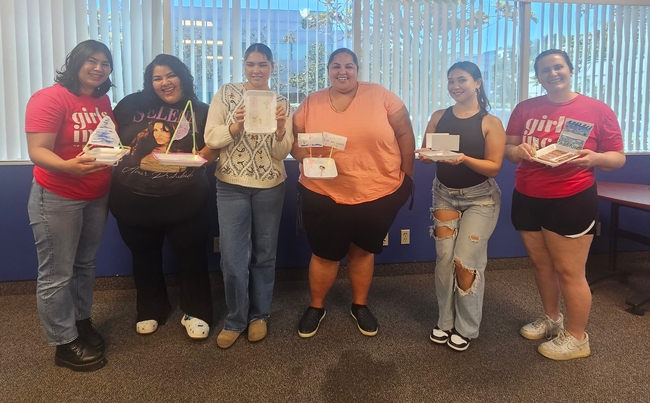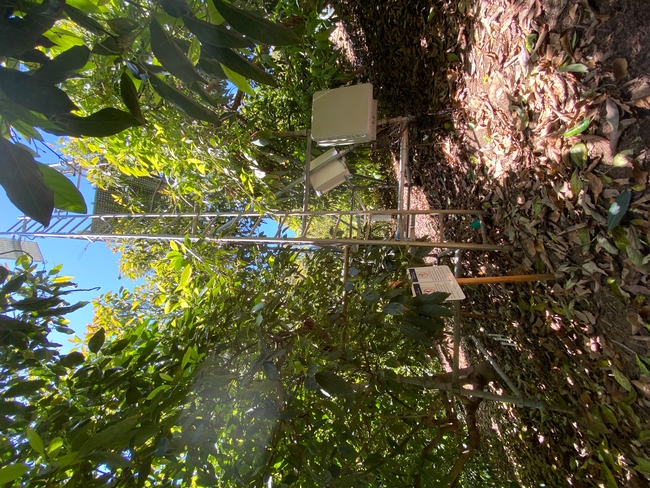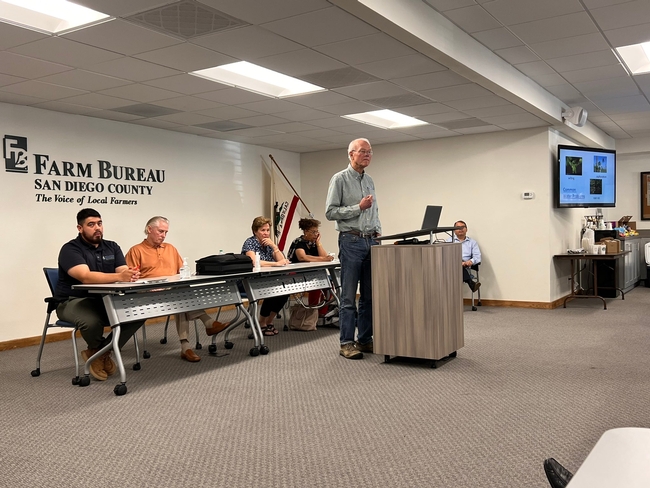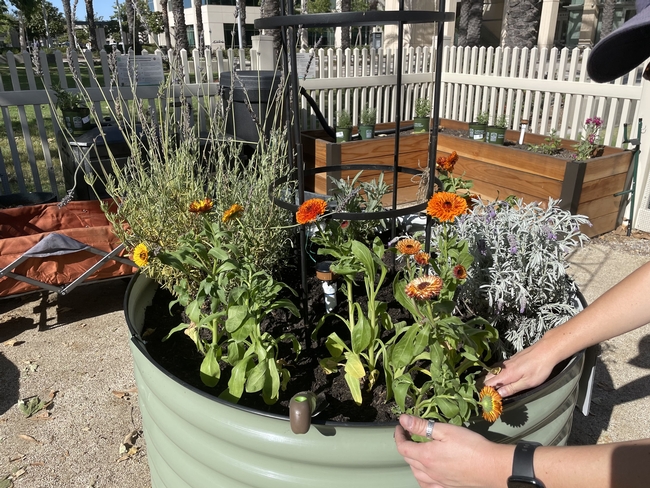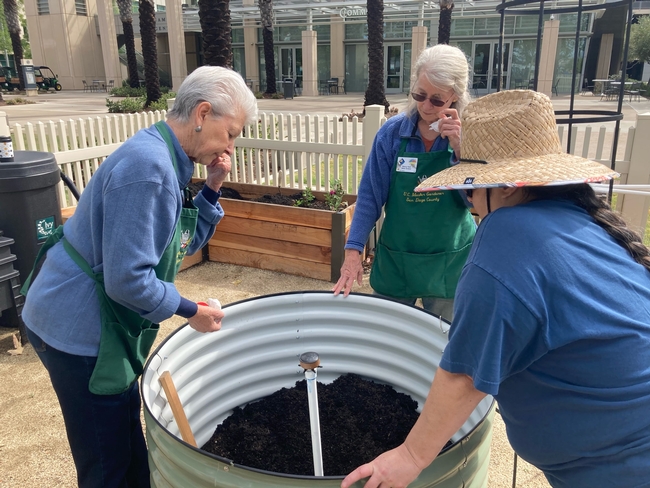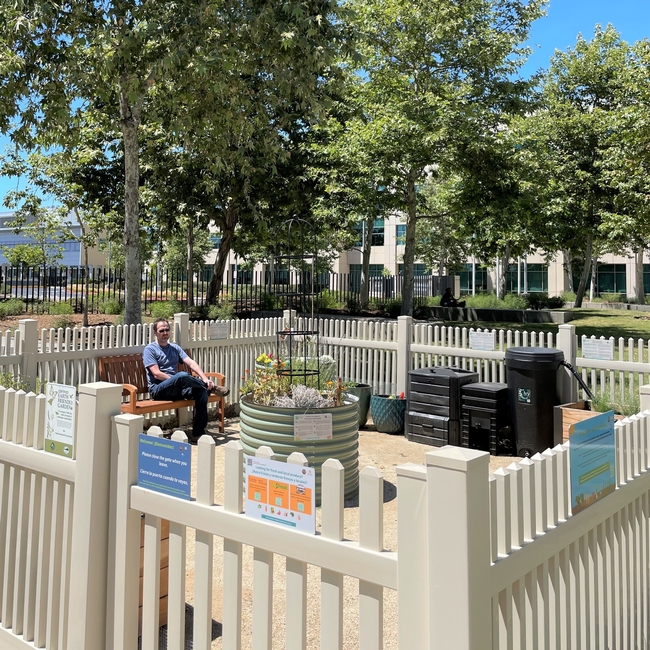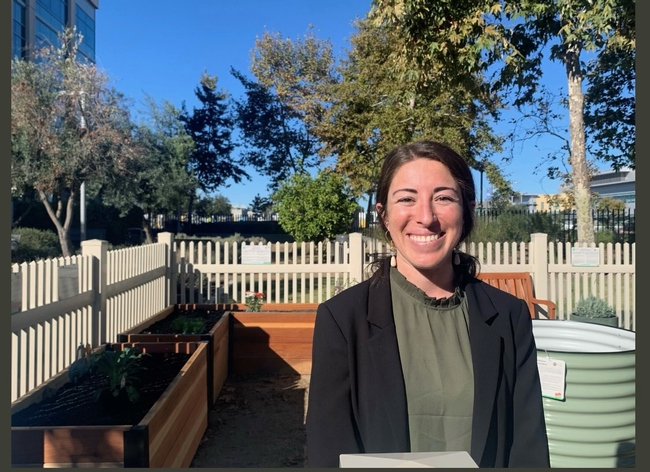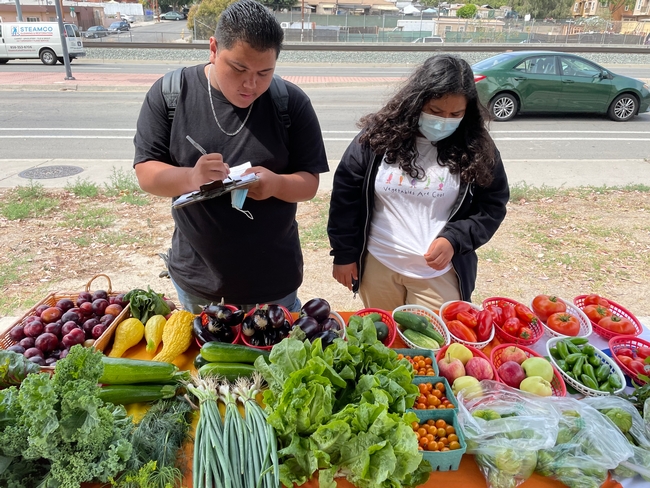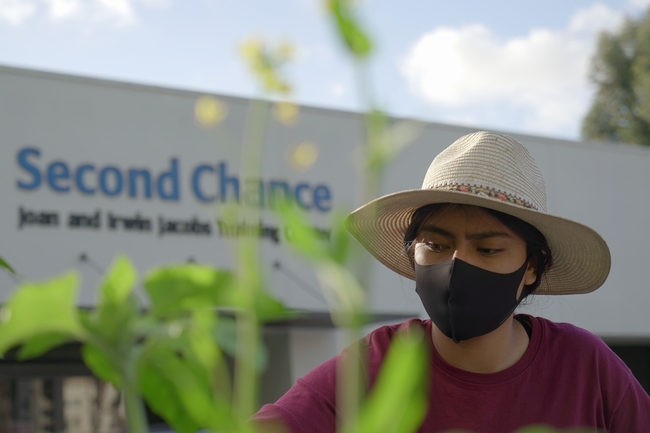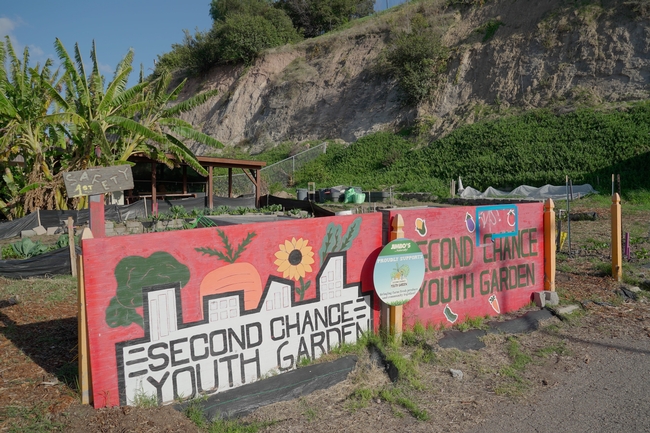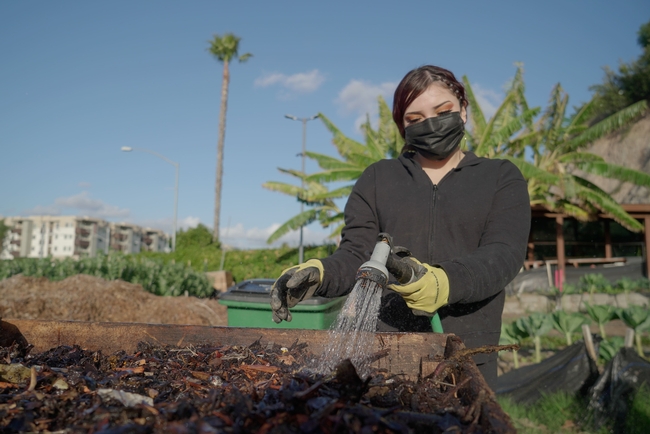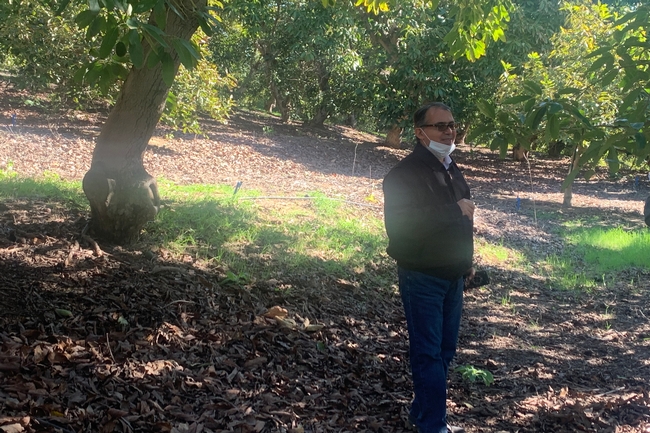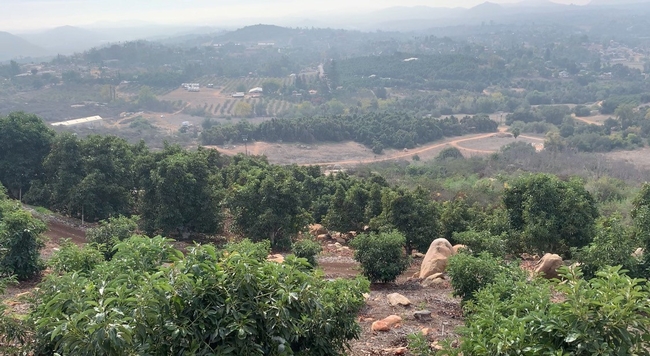Posts Tagged: San Diego County
San Diego County goes green for National 4-H Week with proclamation, lighting ceremony
National 4-H Week is Oct. 7-12, 2024. To celebrate, the San Diego County Board of Supervisors will be recognizing the significant benefits to local youth provided by the UC Cooperative Extension 4-H Youth Development Program in San Diego County with a proclamation on Tuesday, Oct. 8. This recognition will take place at 9 a.m. during the board's meeting at the County Administration Center, 1600 Pacific Highway, San Diego, CA 92101.
In California, 4-H is administered through county-based UC Cooperative Extension advisors and educators who provide practical knowledge to people, businesses and communities via science-based research and educational programs. The proclamation not only celebrates 4-H's impact in San Diego County, but also acknowledges the successful partnership between UCCE and the County of San Diego.
As a leading youth-serving organization nationwide, 4-H offers research-based programs that equip young people with life skills, leadership training and community engagement opportunities. It also provides professional development and resources for other youth-serving organizations throughout participating counties, including San Diego.
Liliana Vega, UCCE 4-H youth development advisor for San Diego and Orange counties, envisions her expertise in justice, equity, diversity and inclusion enhancing positive youth development for all, especially Black, indigenous and people of color. Eager to create culturally relevant experiences that resonate with young people, Vega believes that doing so starts with empowering youth-serving professionals with growth opportunities, equipping staff to engage with the community meaningfully and prioritizing diversity.
“By partnering with local organizations, schools and diverse community groups in San Diego, we can elevate the quality and reach of youth programs throughout the county. Together, we can enhance opportunities in STEM, environmental justice, the arts and workforce development for the next generation,” said Vega, while describing the program's collaboration with the YMCA and Girls Inc. in San Diego as excellent examples.
At sunset on Oct. 8, attendees and passersby will witness the County Administration Center lit in the program's iconic green color, symbolizing the organization's century-long commitment to youth development in San Diego County. The proclamation and lighting ceremony are open to the public, and individuals whose lives have been enhanced by 4-H are encouraged to attend.
For more information about UCCE's 4-H program in San Diego County and details on how to get involved, please visit https://ucanr.edu/sites/4HSanDiegoCounty/. You can also contact Rebeca Manzo at remanzo@ucanr.edu or Liliana Vega at live@ucanr.edu.
San Diego avocado growers look to Cooperative Extension experts to manage water costs
San Diego County used to be home to nearly 25,000 acres of avocado trees but today there are about 14,000. The drastic decrease is largely due to rising costs associated with avocado production, namely the cost of water.
On September 28, avocado growers gathered at the San Diego County Farm Bureau offices for an Avocado Irrigation Workshop facilitated by Ali Montazar, University of California Cooperative Extension irrigation and water management advisor for Imperial, Riverside and San Diego counties.
“All of our information being developed right now is focused on [irrigation] efficiency. Growers want to know how much water they need and what tools they should use to be more efficient,” explained Montazar.
“The sophisticated research in avocado irrigation that Dr. Ali Montazar is conducting is the first of its kind that the University of California has carried out specifically in avocados. His presentation allowed us attendees the opportunity to see and learn about the technology he is employing – from soil moisture sensors to the California Irrigation Management Information System level equipped station.”
Burr is hopeful that Montazar's research will help avocado growers accurately determine the evapotranspiration in an avocado grove or water use specific to avocados, critical parts of how growers select tools to determine irrigation runtimes.
“His presentation that showed his research finding of the avocado Kc (crop coefficient), while very early into his project, was really interesting. It indicates the possibility that we may need to vary the Kc for different times in the growing season, but he is just beginning a two-to-three-year project that will hopefully deliver solid data on what the Kc for avocados is,” said Burr.
Colorado River uncertainty looms
San Diego's avocado production is primarily managed by small farms. According to Montazar, this adds a level of complexity to water management because there is a greater emphasis on irrigation tools and strategies being user-friendly and cost-efficient.
“We don't know the future,” said Montazar. “But we need to be prepared for all consequences. The Colorado River is experiencing a significant water shortage, and this could impact the water supply source for San Diego County from the Imperial Irrigation District Transfer in the future. It is wise to consider enhancing irrigation efficiency as the most viable tool to manage limited water supplies in Southern California.”
Water has always been an issue. In the 1970s, California's water program paved a way for an additional 98,000 acres of agricultural land.
According to a 1970 study analyzing the cost of avocado production in San Diego County, water costs “averaged 3½ acre feet per acre at $60 an acre foot,” which came with the assumption that water costs would remain relatively low and affordable for a long time.
Unfortunately, that is no longer the case. The county of San Diego gets the majority of its water from the Colorado River, which is concerning given five-year projections of the river reaching critically low reservoir levels by 2027.
In fact, beginning in 2023, the San Diego County Water Authority will be raising the rates for water, prompting growers to invest in more efficient irrigation practices (Table 1).
Table 1. Cost for untreated and treated water in San Diego County in 2022 and 2023.
NOTE: An acre-foot is about 325,900 gallons of water.
Training growers on irrigation a top priority
There are no loopholes or short cuts when it comes to irrigation because irrigation is the key to tree health. Ben Faber, Cooperative Extension subtropical crops advisor for Ventura and Santa Barbara counties, points out that tree health is how growers stay in business.
“You can mess up your fertilization program, and you can mess up your pesticide program, but if you mess up your irrigation program, you're out of business,” he said.
According to Faber, efficient irrigation requires a strong grasp on salt management.
“We import water that has a lot of salt in it. So, you've got to figure out how to put the right amount of water on the root zone without causing root health problems,” said Faber.
This process requires meticulous care, as anything that gets below the root zone can cause groundwater contamination – something growers do not want to be responsible for.
While the latest irrigation technology, such as smart controllers, could help growers, Faber said that training and educating farm managers should be the priority.
As Faber puts it, managing irrigation should be “like brushing your teeth” – something that growers do naturally and competently. Many growers are over-irrigating or wasting time trying to resuscitate dying trees. It's important to learn the needs of the tree and, in some cases, it might be best to stop watering all together.
The first step to water efficiency is acquiring knowledge and identifying needs. Because an over-irrigated tree looks just like an under-irrigated tree, it's crucial that growers learn to recognize the difference and plan accordingly.
This is where Cooperative Extension advisors and researchers come in. Opportunities like the Avocado Irrigation Workshop are ideal for growers looking for answers or support.
For more information and to learn about future workshops in San Diego County, visit https://cesandiego.ucanr.edu/.
UC Master Gardeners’ little garden leaves big impression in San Diego
Master Gardener volunteers partner with County of San Diego on new demonstration garden
In a garden with roughly the square footage of a two-car garage, the University of California Master Gardeners and County of San Diego staff have packed a whole lot of learning for the community.
The demonstration garden, which had its grand opening last fall, is now flourishing in its 20-by-20-foot space in a plaza at the heart of the San Diego County Operations Center. Skilled volunteers with San Diego's UC Master Gardeners, a program of UC Agriculture and Natural Resources, maintain its containers of vegetables and herbs, succulents, and native and pollinator plants.
“For such a little garden, there's a lot to look at,” said Karen Morse, a Master Gardener volunteer who helped establish the “demo garden” – a highly visible and accessible teaching tool for the many people who work and conduct business in the surrounding offices.
“We get questions from people just walking by – from the public, from county employees – all the time,” said Leah Taylor, UC Master Gardener program coordinator in San Diego County. “While we're doing what we're doing in the garden, we're a presence for people to just get a quick bite of education.”
The garden also features a “Little Free Library” of gardening books, as well as a compost bin and rain barrel for demonstration purposes. There are also signs (in English and Spanish, as well as additional languages on the garden's website) offering tips on composting/worm composting, pest management, water conservation, climate adaptation, sustainability practices, and health and nutrition. The expertise of a host of county departments and agencies inform the resources.
“The most beautiful thing about that garden is not necessarily the plants – although we love our plants – it's that it showcases almost every county department…all represented in one place and you can find how to connect with those groups, all in one place,” Taylor explained.
During planning for a broader revamp of the Operations Center grounds, the county had approached the Master Gardeners to provide guidance on a public demo garden.
“The County has a long-standing commitment to sustainability and partnership with the University of California Cooperative Extension,” said Rebeca Appel, program manager for the county's Land Use and Environment Group, which spearheaded the effort through the “Live Well San Diego” Food System Initiative. “So it was a natural approach to work with the Master Gardeners with their robust community garden program, and educational outreach in home and urban gardening throughout our region.”
The vision for the garden was shaped by county teams working with Joan Martin and Ellen Cadwallader, co-chairs of the Master Gardener committee that oversees the program's demonstration gardens across San Diego County, including those at Balboa Park and The Flower Fields in Carlsbad.
And while those gardens help raise awareness among the many visitors at those sites, Martin said the newest demo garden provides unique opportunities for ongoing community education, such as lunch-and-learns on specific gardening topics.
“This is the garden where there's really a chance for year-round education and sessions,” Martin said. “We're excited to see it get started and watch it grow.”
Morse and fellow Master Gardener Sandy Main collaborated with Appel to bring those early plans and objectives to verdant life.
“I think we ticked all the boxes of everything they wanted, initially – examples of container gardening, natives, vegetables, herbs, pollinators – and wheelchair accessible,” Morse said.
They have since passed the botanical baton to Skye Resendes, a relatively recent graduate of the Master Gardener certification program. She will coordinate a team of a dozen volunteers in the ongoing upkeep of the County Operations Center demo garden.
Resendes, who uses gardening to help her cope with the stresses of her work as a civil litigator, said she hopes the garden will not only inform the community on crucial ecological and conservation topics but also inspire more people to start their own gardens.
“The science is out there – there are huge mental health benefits to gardening,” Resendes said. “It's an absolute meditation.”
Youth-run garden provides 10,000 pounds of produce for San Diego families
UC SAREP's Sustainable Agriculture and Food Systems grant helps support Second Chance garden
Fifteen-year-old Xavier knows the anger within him will never leave. “I can't ever get rid of it,” he said.
“I've always wanted to just fight for no reason; I just had an anger issue, losing my temper quick with people,” added Xavier, a ninth-grader in San Diego County. “I have high expectations of myself.”
Xavier is working to keep his emotions under control, and he has found a sense of calm through his volunteer work. He was an intern – and then a peer supervisor – in the youth-run garden of Second Chance, a San Diego-based organization that works to break the cycles of poverty and incarceration by providing housing and job training to adults and young people.
Operating their garden as a small farm business, youth in the program, ages 14 to 21, offer produce to the community through their farm stand and a CSA (Community Supported Agriculture) model.
“The project incorporates a ‘farm to fork' approach in which youth not only experience how to grow food, but how to cook and eat healthfully,” said Gail Feenstra, director of the University of California Sustainable Agriculture Research and Education Program, which has a grant program that funds research and education projects – such as the youth garden – supporting sustainable food systems.
“Second Chance works primarily with youth in communities of color, providing them with training and also helping them develop confidence in themselves,” Feenstra said.
Filling a critical need for fresh produce
Caelli Wright, program manager of the Second Chance youth garden, said that grant funds from SAREP – a program of UC Agriculture and Natural Resources – have been used to purchase the supplies needed to sustain the program. The garden has filled a critical need for produce during the COVID-19 pandemic.
“After the pandemic hit, we recognized the increased need for fresh food in our neighborhoods,” Wright said. “That need was already there – southeast San Diego is considered a ‘food swamp' or ‘food apartheid', if you will – and with the onset of COVID, that need just escalated with unemployment and complications in our food production systems.”
Through a partnership with UC San Diego Center for Community Health and Encanto Elementary School (located down the block from the garden), donations enabled the program to give its CSA shares to about 25 families at Encanto. Over the course of the pandemic, the youth have grown 10,000 pounds of produce to donate.
At the same time, the program helps the young participants grow. For Xavier, being outdoors with peers empowered him to develop positive relationships. Previously, as a student in a charter school program, he was not accustomed to interacting with people and groups. Volunteering in the youth garden has given him a fresh perspective and understanding of others.
“Learning to be patient with people and [to] accept sometimes that if I don't know something, I need to ask about it, because I used to be so in my ego that I thought I knew everything,” Xavier explained. “But I don't know everything – I just learned to accept some things…that's just being part of life. And that's something that the garden has helped me with, personally.”
Opportunities for personal, social growth
Developing – and redeveloping – social skills are especially important for students, as they return from the disconnections associated with remote learning.
“Right now, with a lot of students facing the aftermath of COVID and being restricted to learning at home and not getting as much social interaction in their daily lives, it's led to a lot of challenges, mental health-wise, and social and emotional learning-wise,” Wright said. “The garden program provides that opportunity that some youth have been missing out on.”
In southeast San Diego, such crucial opportunities for personal growth and career exploration are harder to come by, and Second Chance started the garden in 2012 to give youth a unique work experience and valuable skills. About 400 young people have participated in the program.
“The youth that we serve are coming from low-income neighborhoods that are underserved with resources,” Wright said. “They just are not exposed to the same opportunities [as those in higher-income areas] to build skills or be ready for the workforce or to reach higher education – so that's where our program comes in and helps deliver those needed services.”
Xavier, who originally came to the garden because he heard that landscaping could be a lucrative career, recently finished his second stint as a peer supervisor in the youth garden. With his new skills, he and his cousin are looking to start a business of their own, cutting grass and doing yardwork in their community.
And, late last month, Xavier transferred to a more traditional high school environment.
“Being in a charter school after two, three years,” he said, “I've realized I miss being around more people.”
Avocado growers to get irrigation tools, strategies from UC ANR’s Montazar
CDFA grant supports research to optimize water use for iconic California crop
California growers, who account for more than 90% of avocado production in the U.S., will soon be getting some help in weathering the extreme fluctuations of climate change.
Ali Montazar, a University of California Cooperative Extension irrigation and water management advisor, recently received a grant to develop tools and strategies that optimize growers' irrigation practices across Southern California – the state's avocado belt. California avocados are valued at more than $411 million, according to the National Agricultural Statistics Service.
“This region faces uncertain water supplies, mandatory reductions of water use, and the rising cost of water – while efficient use of irrigation water is one of the highest conservation priorities,” Montazar said. “Water is the most critically important input to avocado production.”
At the California Avocado Commission's suggestion, Orange County was added to the study to better capture the range of climates and cropping systems across the region, Montazar said.
He hopes to develop “crop coefficients” that avocado growers can use to determine the optimal irrigation for their crop based on a host of factors: soil type and salinity, canopy features, row orientation, slopes, soil and water management practices, and more.
“Growers are unclear on how much water the crop actually needs under those conditions,” Montazar said.
He will incorporate data from the actual water use in the experimental orchards – including information from the newest soil moisture and canopy temperature sensors – to help ensure growers do not under- or overwater their crops. Overirrigating contributes to a devastating disease, avocado root rot, caused by the plant pathogen Phytophthora cinnamomi.
Another component of the grant supports outreach in disseminating these resources and best practices to the broader agricultural community.
“Developing and adopting these tools and information may have a significant impact on water quality and quantity issues and bolster the economic sustainability of avocado production not only in the well-established production region of Southern California, but also in Kern and Tulare counties where new avocado plantings are growing,” Montazar said.
Preliminary findings and recommendations are expected at the end of 2022.

